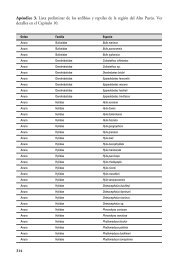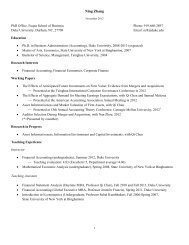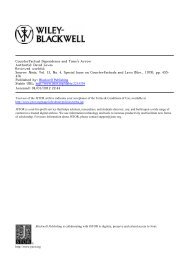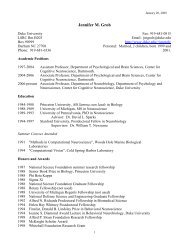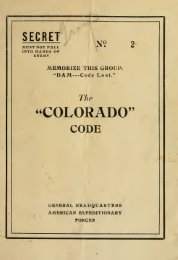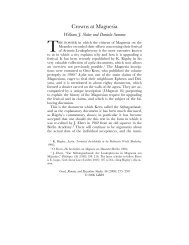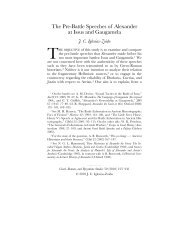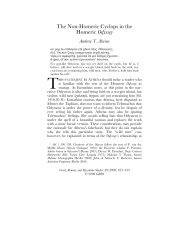Johann Wolfgang von Goethe (1749-1832) - Duke University
Johann Wolfgang von Goethe (1749-1832) - Duke University
Johann Wolfgang von Goethe (1749-1832) - Duke University
Create successful ePaper yourself
Turn your PDF publications into a flip-book with our unique Google optimized e-Paper software.
J. W. v. <strong>Goethe</strong> Page 4 4/4/2008<br />
of nature, it has remained one of the great<br />
milestones of German Shakespeare criticism. Even<br />
more influential was the Shakespearean history<br />
play Götz <strong>von</strong> Berlichingen mit der eisernen Hand: Ein<br />
Schauspiel (Götz <strong>von</strong> Berlichingen with the Iron<br />
Hand; translated as Goetz <strong>von</strong> Berlichingen, 1799),<br />
first drafted in November 1771 and published in a<br />
revised version two years later. The play is based<br />
on a sixteenth-century chronicle in which the old<br />
baron Götz tries to maintain his independence in<br />
the face of the encroaching empire. In the resulting<br />
conflict between tradition and law Götz's side<br />
degenerates, against his will, into open rebellion.<br />
The evil of the court is embodied in the beautiful<br />
Adelheid, who seduces Götz's old friend<br />
Weislingen into breaking his engagement to Götz's<br />
sister Marie. After Weislingen marries Adelheid,<br />
she poisons him. Götz dies in prison, welcoming<br />
the freedom of a higher world. The play is written<br />
in prose (the form of Wieland's translation of<br />
Shakespeare), with explosive diction and many<br />
short scenes. The emphasis on the prosaic aspects of<br />
Shakespearean diction and structure shows that the<br />
play is not only a statement in favor of Shakespeare<br />
but also a rejection of the orderly elegance of French<br />
neoclassical form for German drama.<br />
<strong>Goethe</strong>'s other dramas of the early 1770s are of<br />
three types: short satires, mostly from 1773, on<br />
literary and cultural themes in prose or in<br />
Knittelverse, the doggerel couplets made popular<br />
by Hans Sachs; incomplete poetic dramas on great<br />
figures such as Caesar, Mahomet, Prometheus,<br />
Egmont, and Faust, the extant fragments of which<br />
are among <strong>Goethe</strong>'s finest poems of the period; and<br />
a group of completed plays of more conventional<br />
form--the tragedy Clavigo: Ein Trauerspiel (1774;<br />
translated as Clavidgo: A Tragedy in 5 Acts, 1798), the<br />
drama Stella: Ein Schauspiel für Liebende in fünf Akten<br />
(1776; translated, 1798), and the operettas Erwin und<br />
Elmire: Ein Schauspiel mit Gesang (1775) and Claudine<br />
<strong>von</strong> Villa Bella: Ein Schauspiel mit Gesang (1776).<br />
Clavigo: Ein Trauerspiel and Stella: Ein Schauspiel für<br />
Liebende in fünf Akten both deal with men like<br />
Weislingen who cannot be decisively faithful to a<br />
woman. In the first version of Stella: Ein Schauspiel<br />
für Liebende in fünf Akten the shaky hero is finally<br />
shared peacefully by the two women he has<br />
married; in 1787 <strong>Goethe</strong> gave the play a more<br />
conventional tragic ending. These four plays<br />
mark the beginning of a long series of operettas<br />
and operatic plays in <strong>Goethe</strong>'s oeuvre.<br />
<strong>Goethe</strong>'s poems of this period set new standards<br />
for the genre in Germany. There are ballads,<br />
such as "Der König in Thule" (The King of<br />
Thule, 1782; later included in Faust); love poems,<br />
many of which were later set to music by<br />
Beethoven and Schubert; and occasional poems,<br />
such as the masterpiece "Auf dem See" (On the<br />
Lake), written in response to a boat trip on the<br />
Lake of Zurich in the summer of 1775. There are<br />
also, finally, the great Pindaric hymns--among<br />
them "Wanderers Sturmlied" (Wanderer's Storm<br />
Hymn, included in volume 2 of <strong>Goethe</strong>'s Werke<br />
[<strong>Goethe</strong>'s Works, 1815-1819], 1815),<br />
"Prometheus," and "Ganymed" (both included in<br />
volume 8 of <strong>Goethe</strong>'s Schriften, 1789).<br />
<strong>Goethe</strong>'s most famous work of the 1771-1775<br />
period is Die Leiden des jungen Werthers<br />
(translated as The Sorrows of Werther, 1779),<br />
published in 1774. In this paradigmatic novel of<br />
eighteenth-century sensibility, Werther traces in<br />
a series of letters the course of his love for Lotte,<br />
who is already engaged to a solid young official<br />
when Werther meets her. Misled by the warmth<br />
of Lotte's friendship but most of all by his own<br />
intense imagination--which projects upon Lotte<br />
all the ideals garnered from his reading of<br />
Homer, Goldsmith, and Ossian--Werther<br />
gradually loses touch with the world around<br />
him, ceases to narrate coherently (an editor takes<br />
over the narration), and finally shoots himself.<br />
The novel is based on <strong>Goethe</strong>'s relationship with<br />
Charlotte Buff and her fiancé, Kestner; the<br />
suicide for love of an acquaintance, Karl<br />
Wilhelm Jerusalem, provided the model for<br />
Werther's death. As important as the personal<br />
experiences for the novel are the literary<br />
experiences: the epistolary novel of sensibility<br />
from Samuel Richardson through Rousseau<br />
reaches its zenith in this novel. Through the<br />
passion of Werther the basic patterns of



